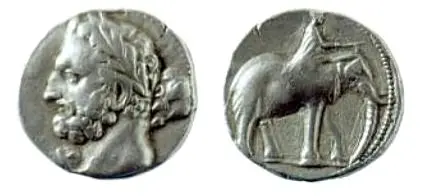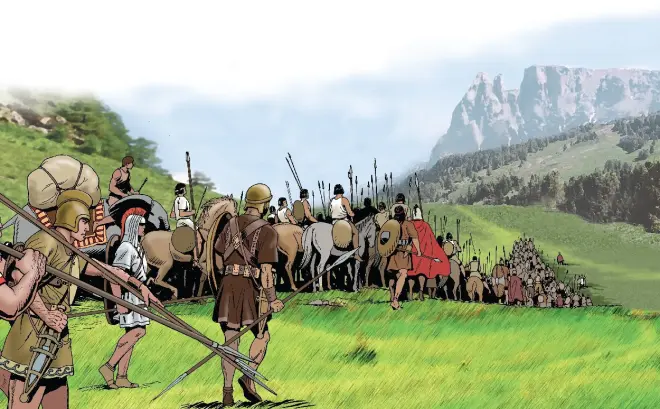【简译】哈米尔卡·巴卡(迦太基将军)

Hamilcar Barca (c. 285 – c. 228 BCE) was a Carthaginian general active in the First Punic War (264-241 BCE). He then quashed a rebellion closer to home between 241 and 237 BCE before returning abroad, where he successfully expanded Carthaginian interests in southern Spain. In these conflicts, Hamilcar had switched Carthage from a naval power to a land power with great success, and he firmly established the Barcid family as the ruling house of Carthage. He was the father of Hannibal Barca who continued his father's tactics and won major land battles in Italy during the Second Punic War.
哈米尔卡·巴卡(约公元前285年-约公元前228年)是活跃于第一次布匿战争(公元前264-241年)中的迦太基将军。他在公元前241年至237年间平息了一场离家较近的叛乱,然后前往国外,成功地扩大了迦太基人在西班牙南部的利益。在对外战争中,哈米尔卡将迦太基从一个海军强国转变成了一个陆军强国,并取得了巨大的成功,他牢固地确立了巴卡家族作为迦太基统治者的地位。他是汉尼拔·巴卡的父亲,在第二次布匿战争期间,汉尼拔继承了父亲的陆军战术,在意大利取得了胜利。
姓名及家庭
'Hamilcar', from the Punic hml-qrt, means follower or servant of Melqart, the Phoenician/Punic god whilst 'Barca' is thought to derive from the Punic word barqa, meaning lightning, and was used in reference to Hamilcar's guerrilla tactics used in the First Punic War.
“哈米尔卡”来自布匿语hml-qrt,意思是腓尼基/布匿神Melqart的追随者或仆人;而 “巴卡”被认为出自布匿语barqa,意思是闪电,并被用来指哈米尔卡在第一次布匿战争中使用的游击战术。
Hamilcar Barca was a member of the Barcid clan of Carthage and the father of Hannibal Barca, Rome's most notorious enemy, who crossed the Alps and caused havoc in Italy in the Second Punic War (218 - 201 BCE). In 237 BCE Hamilcar had famously taken his son, then nine years old, to the temple of Baal in Carthage and made him swear never to be a friend of Rome. Hamilcar's other two sons were Hasdrubal Barca and Hasdrubal Gisco, both of whom commanded during the Second Punic War.
哈米尔卡·巴卡是迦太基巴卡家族(Barcid)的成员,也是罗马最臭名昭著的敌人汉尼拔·巴卡的父亲,汉尼拔在第二次布匿战争(公元前218-201年)中越过阿尔卑斯山,对意大利造成了严重的破坏。公元前237年,哈米尔卡曾把他当时9岁的儿子带到迦太基的巴力神庙,让他发誓永远不做罗马的朋友,这一点非常有名。哈米尔卡的另外两个儿子是哈斯德鲁巴·巴尔卡和哈斯德鲁巴·吉斯科,他们都在第二次布匿战争中担任指挥官。

第一次布匿战争
After 15 years of fighting, there was still no end in sight to the first Punic War. Carthage had beaten a Roman army in Africa, but Rome seemed able to replace their naval fleets at will. Sicily had been the principal battleground but had yet to see a decisive victory for either side. Then the enterprising Hamilcar Barca came to the fore. He replaced Carthalo, who had not been altogether unsuccessful, as the commander of the Carthaginian fleet.
经过15年(公元前264-249)的战斗,第一次布匿战争仍然没有结束的迹象。迦太基在非洲击败了一支罗马军队,但罗马似乎能够随意更换他们的海军舰队。西西里岛是主要战场,但双方都还没有取得决定性的胜利。随后,积极进取的哈米尔卡·巴尔卡出现了。他取代了建树颇少的卡尔塔罗,成为迦太基舰队的司令官。
Hamilcar first raided the Italian coast at Bruttium in 247 BCE, perhaps in search of booty to pay his mercenaries, and then landed on Sicily at Heircte near Panormus (Palermo). This position allowed Hamilcar to hold a mountain base and harass the rear of the Roman forces who were besieging Drepana and Lilybaeum, which were Carthage's last remaining strongholds on Sicily. The Romans responded by blockading Hamilcar, but he seems to have been able to break out regularly and continue his guerrilla tactics. As Carthage no longer had the resources for a large army, he could not face the enemy in an all-out battle, but he did manage to capture Eryx in 244 BCE, which became his new base. This turned out to further restrict his freedom of movement, but the Carthaginian commander continued to coordinate attacks on the Italian mainland, perhaps as north as Cumae. Still, without a significant force at his disposal (fewer than 20,000 men) and despite Polybius' praise that he was the best Carthaginian general of the war, Hamilcar's effect on the conflict was ultimately a limited one.
公元前247年,哈米尔卡首次袭击了意大利海岸的布鲁提乌姆,也许是为了寻找战利品来支付他的雇佣兵的工资,他的军队在西西里岛的帕诺尔穆斯(巴勒莫)附近的希尔克特登陆。哈米尔卡在此能够守卫山地基地,并骚扰围攻德雷帕纳和马尔萨拉的罗马军队的后方,这两个地方是迦太基在西西里岛上剩下的最后据点。罗马人的回应是封锁哈米尔卡,但他似乎能够定期突围,继续他的游击战术。由于迦太基不再能维持大量的军队,他无法在全面战斗中面对敌人,但他确实在公元前244年设法占领了埃里克斯,那里成为他新的基地。但事实证明,这进一步限制了他的行动自由;不过,这位迦太基指挥官继续组织对意大利的攻击,袭击范围可能一直到库马的北部。尽管如此,由于没有可供支配的大量兵力(不到20,000人),尽管波利比乌斯称赞他是战争中最好的迦太基将军,哈米尔卡对冲突的影响最终还是很有限。

The end finally came on 10th March 241 BCE when the Romans defeated a Carthaginian fleet led by Hanno sent to relieve the besieged city of Drepana off the Aegates Islands (Isole Egadi). 50 Carthaginian ships were sunk, 70 captured and 10,000 prisoners taken. This loss was not huge, but after decades of war, it drove the cash-strapped Carthaginians to instruct Hamilcar to seek peace terms. Hamilcar then resigned his command but he would be needed again within months.
公元前241年3月10日,罗马人击败了一支由汉诺率领的迦太基舰队,该舰队被派去解救伊盖茨群岛(Isole Egadi)外被围困的德雷帕纳城。50艘迦太基船只被击沉,70艘被俘,10,000名士兵被俘。这一损失在过去并不巨大,但经历了几十年的战争,它促使资金紧张的迦太基人指示哈米尔卡寻求和平协议。哈米尔卡随后辞去了指挥职务,但几个月内,迦太基又需要他的帮助。
佣兵战争(The Truceless War)
Not only did the Carthaginians lose the First Punic War and so the control of Sicily but they were also compelled to pay huge reparations to Rome. Then the so-called Truceless War (also Mercenary War) broke out in 241 BCE. Carthage faced a joint rebellion of mercenary troops, understandably upset at not having been paid for their efforts in the first Punic War, Libyan groups seizing the opportunity of a weakened Carthage to rebel, and several cities looking for independence such as Tunis and Utica. Hamilcar Barca was recalled from Sicily and he joined Hanno the Great, who had made significant conquests in Libya while Hamilcar had been in Sicily, to quash the rebellion. First, Hamilcar broke the rebel siege of Carthage and then defeated an army led by Spendius near the Bagradas River. Hamilcar had managed to persuade the Numidian prince Naravas to defect with his cavalry force to the Carthaginian side, lured by the promise of Hamilcar's daughter for his wife. Hamilcar now had an army of 12,000 and 70 elephants with which to face the rebels.
迦太基人不仅在第一次布匿战争中失利,从而失去了对西西里岛的控制,而且还被迫向罗马支付巨额赔款。公元前241年爆发了所谓的残酷战争(The Truceless War)(也是雇佣兵战争)。迦太基面临着雇佣军的联合叛乱,他们对在第一次布匿战争中没有得到报酬感到不满是可以理解的;利比亚佣兵抓住迦太基被削弱的机会进行叛乱,还有一些城市寻求独立,如突尼斯和乌提卡。哈米尔卡·巴卡被从西西里召回,他与在西西里时在利比亚取得重大征服的汉诺大帝一起平定了叛乱。首先,哈米尔卡打破了叛军对迦太基的围困,然后在巴格拉达斯河附近击败了斯宾迪乌斯率领的军队。在哈米尔卡的女儿为其妻子的承诺诱惑下,哈米尔卡成功地说服了努米底亚王子纳拉瓦斯,,带着他的骑兵部队投奔迦太基一方。哈米尔卡现在拥有一支12000人的军队和70头大象,可以应对叛军。

Elsewhere, things did not go so well. Hippacra and Utica were both besieged, and Hanno was unable to free them. In 239 BCE a mercenary force took control of Sardinia and then defeated a Carthaginian army sent to re-take the island. In the same year, both Hippacra and Utica joined the rebels. The war was now becoming particularly brutal with atrocities committed on both sides. The rebels mutilated prisoners, and Hamilcar had his captives trampled on by elephants. Long-time rivals Hamilcar and Hanno could not agree on the best strategy and eventually the army was permitted to choose which general should lead them. They chose Hamilcar.
在其他地方,事情并不那么顺利。希帕克拉和乌提卡都被围困了,而汉诺无法解放它们。公元前239年,一支雇佣兵部队控制了撒丁岛,然后击败了被派去重新夺取该岛的迦太基军队。同年,希帕克拉和乌提卡都加入了叛军。现在,战争变得特别残酷,双方都犯下了暴行。叛军残害俘虏,哈米尔卡则让大象践踏俘虏。长期以来,哈米尔卡和汉诺无法就最佳战略达成一致,最终军队被允许选择哪位将军来领导他们。士兵们最终选择了哈米尔卡。
The war started to improve for Carthage when they were aided by Rome, who repatriated captured Carthaginian soldiers for free, and the tyrant of Syracuse Hiero, who feared that without Carthage then Rome might act at will in the central Mediterranean. Hamilcar broke off the second siege of Carthage by Mathos and headed inland where a rebel army awaited him. There, after several skirmishes, Hamilcar cornered the enemy at 'the Saw' (Prion), a ridge in the Libyan mountains. The rebel army was starved of supplies and eventually sought to surrender. Hamilcar refused and slaughtered all of them except for the commanders. These were taken to Tunis, the rebel capital, and crucified in full sight of Mathos' army. Meanwhile, Mathos had defeated a Carthaginian army, and he dealt the same treatment to the captured Carthaginian general. Mathos could not, though, resist a joint army of Hamilcar and Hanno, and he was driven out of the city and defeated at Byzacium. Finally, with the fall of the rebel capital in 237 BCE, Hippacra and Utica back on the Carthaginian side, and Libya now compliant, Carthage had regained control of its African empire. Hamilcar and the Barcid line would now dominate the Carthaginian political and military arenas for the next 35 years.
迦太基得到了罗马的援助,罗马免费遣返了被俘的迦太基士兵,而锡拉库扎的暴君希罗则担心没有迦太基,罗马可能会在地中海中部随意行动,于是战争局势开始好转。哈米尔卡打破了马托斯对迦太基的第二次围攻,他的军队向内陆进发,那里有一支叛军在等着他。在那里,经过几次小规模的战斗后,哈米尔卡将敌人逼到了"锯"(Prion)--利比亚山脉的一个山脊。叛军物资匮乏,最终寻求投降。哈米尔卡拒绝了叛军,并屠杀了他们所有的人——除了指挥官。这些人被带到叛军的首都突尼斯,在马托斯军队的眼皮底下被钉死。与此同时,马托斯还打败了一支迦太基军队,他对被俘的迦太基将军也给予了同样的待遇。不过,马托斯无法抵挡哈米尔卡和汉诺的联合军队,他被赶出了城市,并在拜扎凯纳(Byzacium)被打败。公元前237年,随着叛军首都的陷落,希帕克拉和乌提卡归顺迦太基,利比亚现在也顺从了,迦太基重新控制了其在非洲的势力范围。哈米尔卡和巴卡家族将在未来35年内主宰迦太基的政治和军事。

哈米尔卡在西班牙
Carthage was on the rise again and eager to create a wider Mediterranean empire. Without a significant fleet and having lost their strategically important fortresses in Sicily, Corsica and Sardinia, the Carthaginians, though, had to look elsewhere for a source of money to fund their armies. The answer was Spain. They had long since had control of the old Phoenician colonies there, and it had already proven a rich source of silver. Accordingly, Hamilcar Barca was dispatched in 237 BCE to expand Carthaginian territory, which he did, establishing his base at Gades (Cadiz) and founding a new city of Acra Leuce. He supplemented his original force of some 25,000 with local recruits and amassed a 50,000-strong army which included a corps of Numidian cavalry (supplied by Prince Naravas) and 100 elephants. Using a blend of terror and diplomacy Hamilcar relentlessly expanded his control over southern Spain. The riches from these campaigns were channelled back to Carthage. Hamilcar's move away from the traditional naval power of Carthage to a land force was reaping fantastic rewards.
迦太基再次崛起,他们渴望建立一个更广泛的地中海帝国。由于没有一支重要的舰队,并且在之前的战争中失去了西西里岛、科西嘉岛和撒丁岛的重要战略要塞,迦太基人不得不从其他地方寻找资金来源以资助他们的军队——答案是西班牙。他们早就控制了那里的旧腓尼基殖民地,而且那里已经被证明是一个丰富的银源。因此,哈米尔卡·巴卡于公元前237年被派去扩大迦太基的领土;他做到了,在加的斯(Cadiz)建立了基地,并建立了一个新的城市Acra Leuce。他用当地的新兵补充了原有的约25000人的部队,并组建了一支50,000人的军队,其中包括一支努米底亚骑兵团(由纳拉瓦王子提供)和100头大象。哈米尔卡利用恐怖和外交手段,无情地扩大了他对西班牙南部的控制。这些战争财富被陆续输送回迦太基。哈米尔卡从迦太基的传统海军力量转向陆军,获得了巨大的回报。
By the time Hamilcar had conquered southern and south-east Spain, Rome became suspicious of their old enemy's intentions. Envoys were sent to Hamilcar demanding an explanation. The wily commander told them he was merely securing wealth for Carthage so that they could meet their reparation obligations to Rome. Certainly, tribute in money, if not men, was extracted from local cities and new silver mines were worked. The Carthaginian's, in any case, continued campaigning in Spain. After the siege of Helice and betrayed by local allies, Hamilcar retreated and drowned while crossing a river in the winter of 229/228 BCE. Hasdrubal the Fair then took over command of the Carthaginian army. When he was replaced by Hannibal in 221 BCE, the Carthaginians broke the territorial agreement with Rome of 226 BCE not to cross the River Ebro and attacked Rome's ally Saguntum (Sagunto). This led to the Second Punic War and Hannibal taking the army across the Alps into Italy. Hamilcar had indeed got his wish that the Barcid line would be no friend of Rome.
当哈米尔卡征服了西班牙南部和东南部时,罗马对他们的老对手的意图产生了怀疑。特使们被派往哈米尔卡驻地,要求他作出解释。这位狡猾的指挥官告诉他们,他只是在为迦太基争取财富,以便他们能够履行对罗马的赔偿义务。当然,他们继续从当地城市榨取金钱,还有开采新的银矿。无论如何,迦太基人继续在西班牙开展活动。公元前229/228年冬天,哈米尔卡在围攻赫利斯后被当地盟友出卖,在渡河时淹死了。公平者哈斯德鲁巴随后接管了迦太基军队的指挥权。当他在公元前221年被汉尼拔取代后,迦太基人破坏了公元前226年与罗马达成的不渡过埃布罗河的领土协议,并攻击了罗马的盟友萨贡托(Saguntum)。这导致了第二次布匿战争的爆发,汉尼拔带着军队越过阿尔卑斯山进入意大利。哈米尔卡确实如愿以偿,巴卡家族不会是罗马人的朋友。

参考书目:
Bagnal, N. Punic Wars. Thomas Dune s, Hardcover (2005), 2016.
Bagnall, R. et al. The Encyclopedia of Ancient History. Wiley-Blackwell, 2012
Hornblower, S. The Oxford Classical Dictionary. Oxford University Press, 2012.
Hoyos, D. et al. A Companion to the Punic Wars. Wiley-Blackwell, 2011.
Hoyos, D. The Carthaginians. Routledge, 2016.
Steinby, C. Rome versus Carthage. Pen & Sword Maritime (2014-10-30), 2016.

作者:Mark Cartwright
驻意大利的历史作家。他的主要兴趣包括陶瓷、建筑、世界神话和发现所有文明的共同思想。他拥有政治哲学硕士学位,是《世界历史百科全书》的出版总监。

原文网址:
https://www.worldhistory.org/Hamilcar_Barca/




